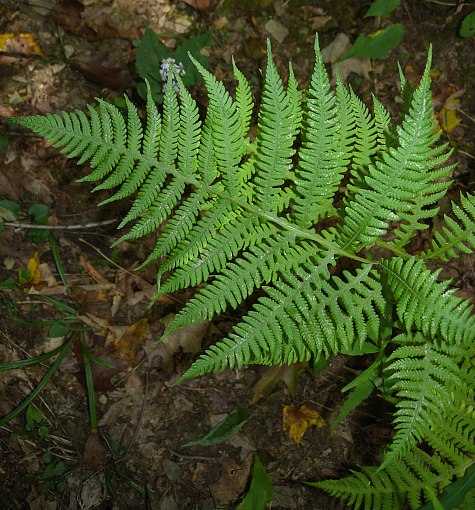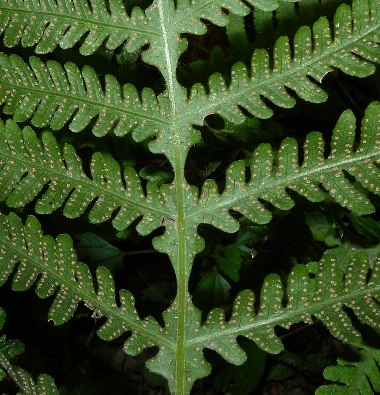Description: This perennial fern consists of a loose cluster of compound leaves on slender petioles; it is about 1-2' tall. The petioles are usually straw-colored and more or less covered with brown scales; sometimes they are short-hairy near the blade. As the season progresses, the petioles may lose most of their scales and become nearly glabrous. The compound leaves are up to 16" long and up to 10" across; in outline, they are deltate-sagittate. The structure of each compound leaf is mostly pinnate-pinnatifid, consisting of 12-20 pairs of leaflets. The leaflets are longer toward the bottom than the top; most leaflets are joined together at the base by a winged extension of the rachis (central stalk of the compound leaf); the margin of this winged extension is irregularly curved. However, the lowest 1-2 pairs of leaflets are not joined together at the base. The lowest pair of leaflets angles downward, while the remaining leaflets are widely spreading. Individual leaflets are narrowly oblong-elliptic to linear-oblong in outline and pinnatifid in structure. Each leaflet has 10-20 pairs of deep lobes; these lobes are usually short-oblong in shape. The margins of these lobes are usually smooth or slightly crenate; however, sometimes the lobes are shallowly pinnatifid, particularly for the lower leaflets.

The upper surface
of each compound leaf is light to medium green and usually hairless;
the lower surface is pale green and either short-hairy or glabrous. The
light green rachis is sparsely to moderately covered with brown scales
and sometimes short-hairy; less often, it is glabrous. On the underside
of each leaf, small round sori (spore-bearing structures) are located
near the margins of the leaflets; they lack indusia (thin protective
membranes). The spores are released during the fall, after which the
leaves die down for the winter. The root system is fibrous and
rhizomatous, periodically producing new leaves from the rhizomes.
Cultivation:
This fern prefers light to moderate shade, moist to dry-mesic
conditions, and a somewhat acidic soil with organic matter. It also
adapts to thin rocky soil if there is sufficient dampness.
Range & Habitat:
The native Long Beech Fern is found in widely scattered locations
throughout
Illinois (see Distribution
Map); it is rare and state-listed as 'endangered.' Habitats
include upland deciduous woodlands, rocky wooded slopes, rocky bluffs,
rocky banks of streams in wooded areas, sandstone ravines, and shaded
sandstone cliffs. To the east of Illinois, this fern can be found in
woodlands where American Beech trees are present. This fern is found in
higher quality natural areas.

Faunal
Associations:
Information about floral-faunal relationships for this fern are
unavailable.
Photographic Location:
A deciduous woodland at Turkey Run State Park in west-central Indiana.
Comments:
The most unusual characteristics of this moderately sized fern are the
winged extension of the rachis and the lack of indusia on the sori (see
the description above for short definitions of these technical terms).
It is relatively easy to confuse the Long Beech Fern with the Broad
Beech Fern (Phegopteris hexagonoptera); the latter
fern is much more
common in Illinois. Generally, Long Beech Fern has compound leaves that
are longer than they are wide, while the compound leaves of Broad Beech
Fern are about as long as they are wide. For Long Beech Fern, the
winged extension of the rachis doesn't reach the lowest 1-2 pairs of
leaflets, while all of the leaflets of Broad Beech Fern are winged at
the base. The winged extension of the latter fern tends to be more wide
and angular, producing hexagonal shapes. Another difference between
these two species consists of the following: the tips of the leaves and
leaflets tend to be more long and slender in the Long Beech Fern than
in the Broad Beech Fern.